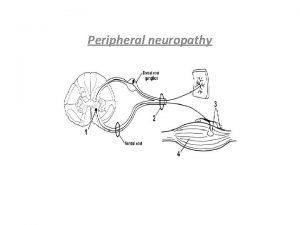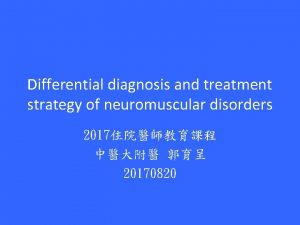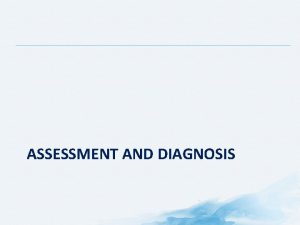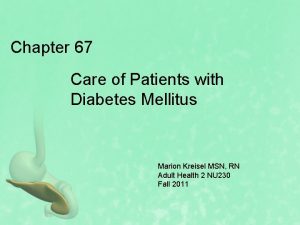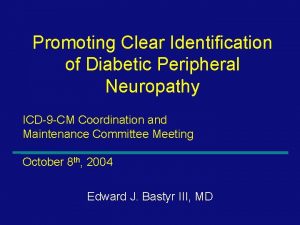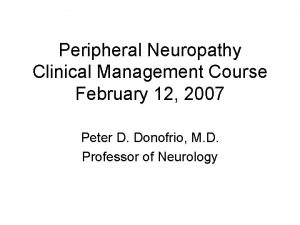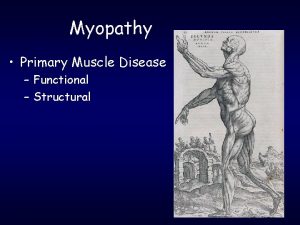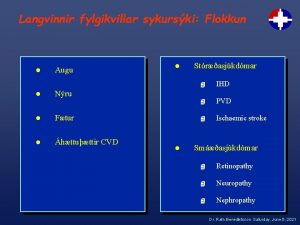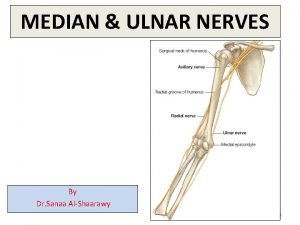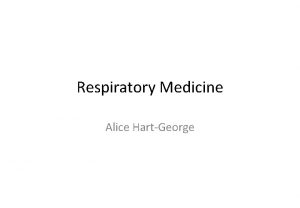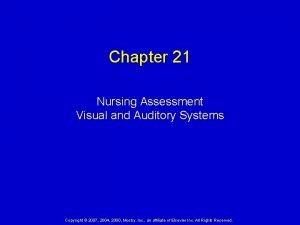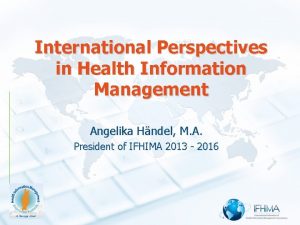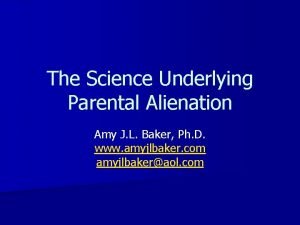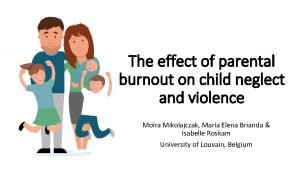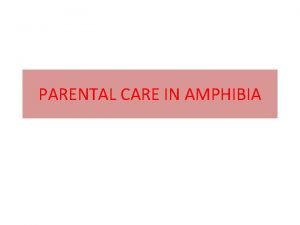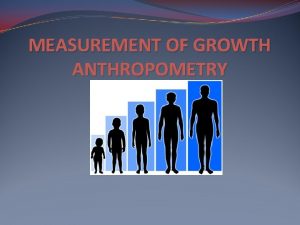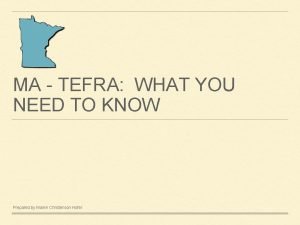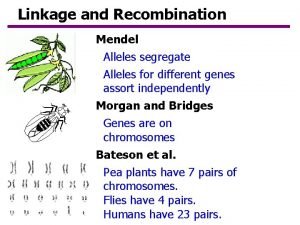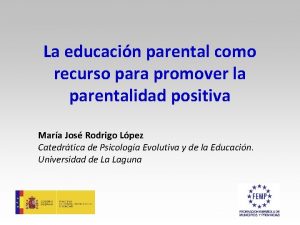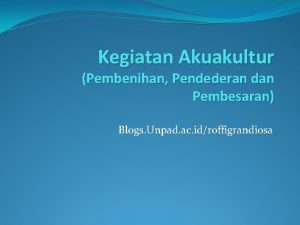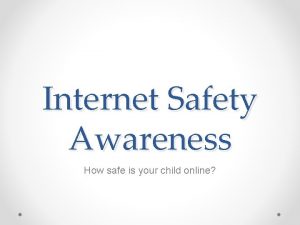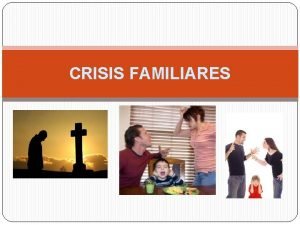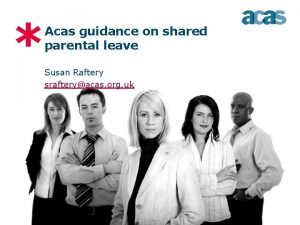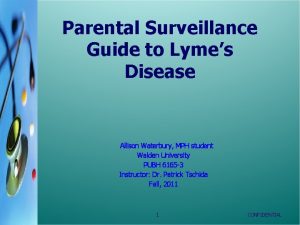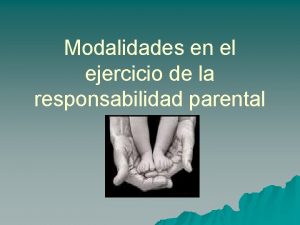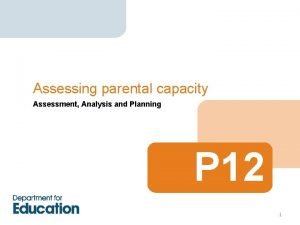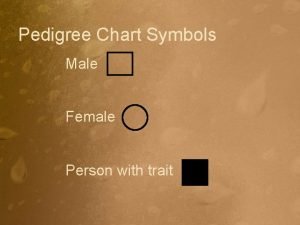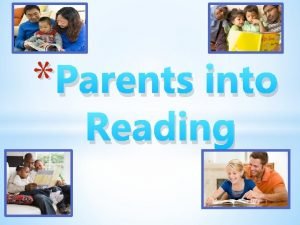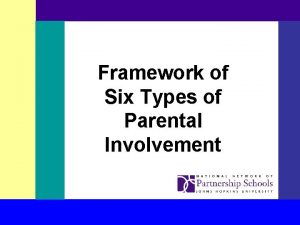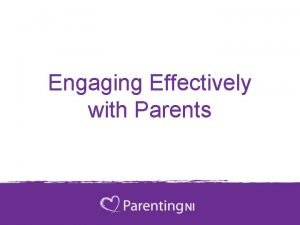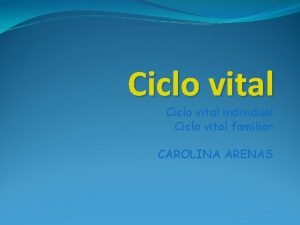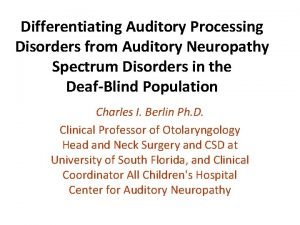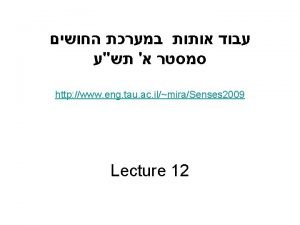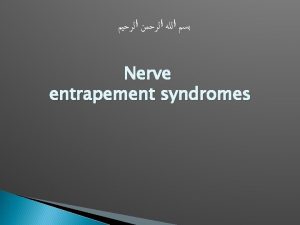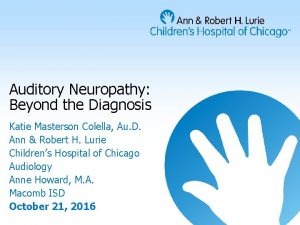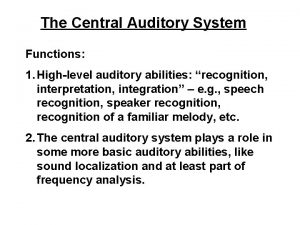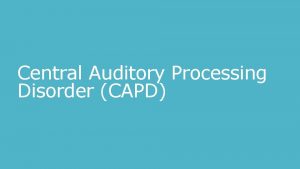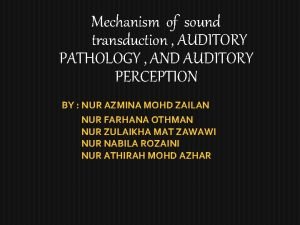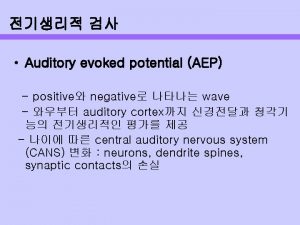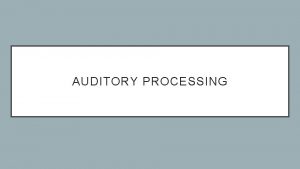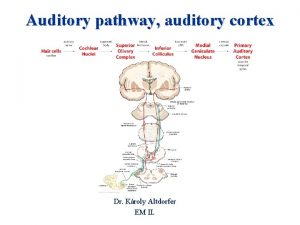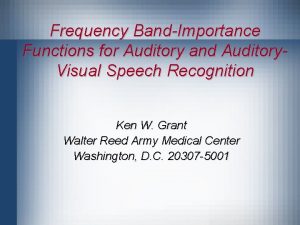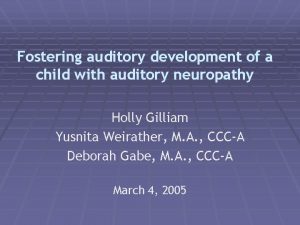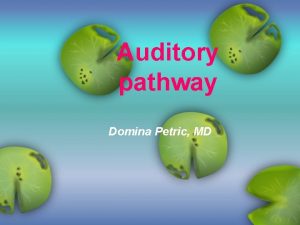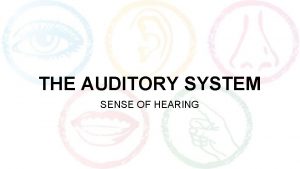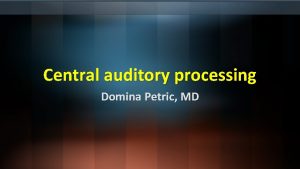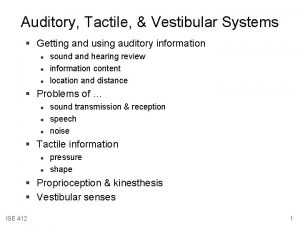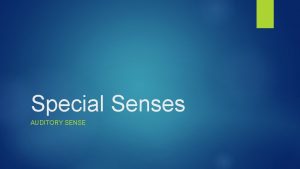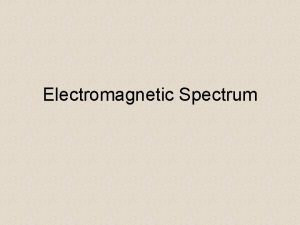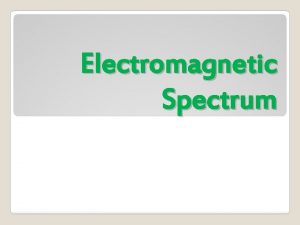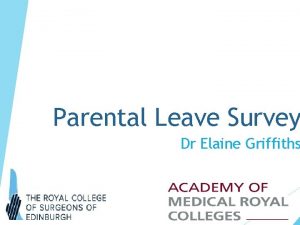Parental Perspectives on Management in Auditory Neuropathy Spectrum







































- Slides: 39

Parental Perspectives on Management in Auditory Neuropathy Spectrum Disorder Kai Uus, MD, Ph. D Audiology & Deafness Research Group School of Psychological Sciences University of Manchester From the Study ‘Experiences of Parents Whose Babies are Identified with Newborn Auditory Dys. Synchrony through NHS Newborn Hearing Screening Programme’ Funded by the NDCS Exeter, 7 th July 2015

Acknowledgements • Prof Alys Young • Marianne Day • The authors thank the families who participated in the study, the Teachers of the Deaf and National Deaf Children’s Society for supporting the study and help with recruiting families • The study was funded by the National Deaf Children’s Society

Epistemology • • The study sought to place parents in the centre of knowledge generation about their own experience and set out to enable parents to construct to professionals what it is that should be known Constructivist epistemology was adopted because: – – – there was no prior research on parents with ASND on which to build; it was assumed that previous studies of the experiences of parents of early identified deaf children (e. g. Young 2010) were fundamentally not relevant to particular circumstances of parents of infants with ANSD; an objective of the research overall was to use its findings to inform new professional guidelines for practice, therefore we sought to invest authority in privileging parents’ experience and understanding within that end process.

Methodological approach • • qualitative study, based on narrative storytelling a questionnaire to collect sociodemographic information and more detailed information about the child’s medical and audiological profile

Sampling • • a purposive convenience-based sampling a sample size of 21 interviews of parents of children identified with ANSD no attempt at statistical analysis instead, it is the in-depth and qualitative comparison of individual case-studies which is valid here

Analysis • • The unit of analysis in this study is the interview rather than the individual respondent Data were audio recorded and transcribed in full Codes were generated independently by members of the research team, then compared for consistency or deviance Accounts were then analysed using thematic content analysis using NVivo

Themes • • Wider health context Uncertainty Advice and improvements Choices and decisionmaking Hearing aids Cochlear implants Sign language How parents explain ANSD • Child identity • Outcomes and development • Newborn hearing screening • What kind of parent do you have to be • Ignorant professionals

Conflicting information All parents talked about getting conflicting information from everywhere: – ‘and she just said you know. . there’s obviously sign language and cued speech and. . . (…) and she did say there’s a whole school of thought around. . hearing aiding or not…. . implanting or not. . and there’s a whole other school of thought around. . . sign language or not…. cued speech or not. . . both or not (laughs). . so you just sit there thinking. . . what do I do for the best. . … I think we know what the options are so. . . you know we might …. see her with a hearing aid in. . we might see her with a cochlear implant. . she might get completely better and she might not. . it might get worse’ (F 1)

Challenges in ANSD • ABR cannot be used to estimate hearing thresholds • Even if we obtain the hearing thresholds, they will be a poor predictor of perceptual abilities • ANSD-specific changes: daily fluctuations, deterioration, improvement and even complete (? ) recovery • Management? ? ? : – Heterogeneity of the condition – Evidence base weak

Management options • • • Visual communication Hearing aids Cochlear implants Combination of the above No necessary (transient ANSD)

Visual communication • 16 out of 21 families, had at least attempted some form of visual communication: • Some challenges similar to ‘typical’ SNHL, some ANSD-specific.

Visual communication Child’s additional needs made adopting sign language difficult: – ‘we started almost immediately after the diagnosis, we had been lucky we had a support worker coming home and teaching me the basics. . . so we could introduce it. . . but (child’s name) didn’t really…take to it. . . probably you know considering his hemiplegia and his visual problems…no wonder. . (F 9)

Visual communication Because of the nature of ANSD, hesitation from clinicians and parents themselves: – ‘they told we’re not sure what we’re dealing with’ (F 4) – ‘well the signing thing I was told by the…educational audiologist…that we should be signing and I suggested Makaton because. . . British sign language (laughs). . . I mean that’s a language in itself it’s like. . . saying to me you’ll have to learn Portuguese to speak to your child and…I’m like I can’t learn that I can’t do it and I’m not prepared to do it I think we should. . . see whether he’s gonna’ (F 5)

Visual communication There were practical difficulties also such as finding the time to attend courses as well as lack of funding for families whose child did not have an audiogram to evidence deafness: – ‘Funding the early years because of funding. . . that is for deaf children and deaf children only’ (F 12)

Visual communication A big issue when choosing visual communication, BSL in particular, is with the challenges with regard to child’s identity. Deaf identity can be very hard for extended family or close friends to accept or understand. This was because the child’s auditory behaviour, in particular responses to sound, seemed to challenge parents’ assumptions and acceptance that their child was deaf: – ‘my mum says why are you doing that sign language she’s not deaf’ (F 8)

Visual communication In the hindsight, the overwhelming advice the parents in our study who had tried sign language would give to other parents of ANSD children, was to seriously consider sign language: – I would. . I would say to them do as much signing as you can because if that child can hear. . just a little bit he might have difficulty in speaking so you’re still going to need sign language to communicate with him anyway. . . so do and learn as much sing language as you can (F 12) – yeah everything sign language anything that would you know make life better for them you know (F 20)

Hearing aid fitting Three types of hearing aid candidacy issues: – i) the child MIGHT NOT NEED hearing aids because her hearing would improve; – ii) hearing aids MIGHT NOT WORK in that particular child and other options such as sign language or cochlear implantation would be more suitable; – iii) hearing aids NEVER WORK in ANSD, an approach that after Rance et al (2002) paper appears to have largely discredited and is less prevailing within the more knowledgeable and informed professional community, with the published guidelines (Northern 2008) supporting the notion of at least trialling amplification.

Hearing aid fitting • from clinical experience with adults, the established approach in management and intervention when it came to hearing aid candidacy was: hearing aids are not beneficial (Starr et al, 1996) • risk of damaging intact cochlear structures such as outer hair cells was raised (Berlin, 1999) • this approach was challenged by Rance et al (2002) who showed that approximately half of the children diagnosed with ANSD benefited from hearing aid fitting evidenced by considerable improvement in their speech perception (Rance et al, 2002) • the current guidelines recommend trial hearing aid fitting in these children (Northern, 2008) • however the challenges remain

Hearing aid fitting The ‘intuitive’ candidacy advice from the extended family: – ‘my sister seems to think you know. . . put it’s like wearing glasses erm… you can’t see so you put your glasses on you can see all day every day and that’s it, you’re ok now’ (F 5) – ‘the grandparents are a little bit more well…. look he can hear us, it’s gonna be ok he’s gonna be alright, isn’t he? He’s going to be able to hear, he won’t need the hearing aids …’ (F 4).

Hearing aid fitting Hesitation about reinforcing hearing aids in very young children: – ‘he doesn’t like what he hears and it’s not helpful why should I or should I trust him…that he doesn’t want to wear it because he doesn’t it’s not good for him…or should I push…mmm it’s tricky’. (F 9) – ‘if it was the nerve that was the problem and he could actually hear ok…then by giving him a hearing aid…you might be amplifying the sound too much for him and he might not be able to tolerate that even and he still won’t be able to hear any better erm…. ’ (F 12)

Hearing aid fitting Will hearing aid damage the perfectly functional outer hair cells whose integrity can be evidenced by normal OAEs and/or CM? A minority of parents (F 1, F 13, F 16) pick up on that and express their worry about the damaging effect of the amplification: – I understand why he can’t have. . . hearing aids and I think. . I kind of came to that conclusion myself though from on the internet when I realised kind of properly that the inner ear’s functioning fine then obviously if you put a hearing aid on then it would damage. . . but nobody really explained that on the first. . . kind of. . . meeting. (F 13)

Hearing aid fitting Some parents express not having confidence in the choice of hearing aid fitting strategy: – I we did have a sort of discussion about how they were going to set her hearing aids ’cos some people believe to set it by the audiogram. . . and some people believe to set it conservatively. . . and then if you get no response increase it because at the end of the day you don’t know what noise that child’s getting. That were a concern and I did feel quite anxious at that point looking back ‘cos I just thought god they really don’t know you know. . . (F 14)

Hearing aid fitting Out of 16 cases from our sample of 21 where hearing aids were trialled, 5 families found amplification very beneficial and 3 somewhat beneficial: – aids are good erm. . . (F 5) – erm and yet he responds so well (F 16) – I do think it does make a difference when he’s got them in he seems to be more attentive when he’s got them in. . . (F 19) – oh yeah massive. . . . the change in him is…yeah. . . his understanding of words is just brilliant. . . really brilliant. . . (F 4) – you can talk behind him and everything he’ll understand everything he doesn’t need to see your mouth but when you do that he knows it’s a game he’s trying to work out so. . (F 11)

Hearing aid fitting

Hearing aid fitting Even the families, who reported great benefits, described the pressure to make the child wear hearing aids: – pulls them out he’s a pain in the backside (laughs) with his hearing aids he’d much rather eat them than wear them. . (F 16)

Hearing aid fitting A few parents (N=8/21) said they did not find hearing aids beneficial, either because of tolerance issues: – ‘dreadful. . . he hates them. . . ’ (F 2), ‘ – she wasn’t tolerating them’ (F 12), – ‘no…she wouldn’t keep them in anyway (laughs). . ’ (F 15) or simply because they did not appear to work for the particular child – ‘they clearly don’t make any difference…’ (F 3).

Hearing aid fitting Even if hearing aids did not work for their child, many families would still recommended trying them to other families with children identified with ANSD: – ‘it’s worth trying yeah it’s got to be worth trying but. . . obviously with (child’s name) it’s not’ (F 12).

Cochlear implantation Controversies surround cochlear implantation in ANSD Based on the clinical experiences with adults with ANSD who predominantly suffer from a neurodegenerative disease, hesitation by professionals about whether cochlear implants even worked for ANSD. Many parents pick up on this: – no I mean well someone said that wouldn’t work for auditory neuropathies is that right would you know… yeah somebody told us it’s not an option for us to be honest. . (F 15)

Cochlear implantation • Electrical stimulation can result in synchronised neural impulses sufficient for auditory stimulation in some patients with ANSD (Shallop et al 2001, Madden et al 2002, Sininger & Trautwein 2002, Mason et al 2003, Peterson et al 2003, Rance & Baker 2008, Teagle et al 2010). • Recent studies, however, state that outcomes for ANSD children are comparable with those of children with ‘typical’ SNHL (Breneman et al. 2012; Budenz et al. 2013). • Success of CI likely linked to the site of lesion (Mc. Mahon et al. , 2008): in pre-synaptic lesions CI likely better outcomes. • Poor outcome when: – CNS pathology on MRI – Absent/abnormal ECAPs

Cochlear implantation Parents were understandably very concerned about the potential harm of CI, particularly considering the uncertainty surrounding ANSD in infants: – we still think about it sometimes but. . . it’s like. . . if we took his coch- if we did that now and then he couldn’t hear anything which it could be and it’s a big operation. . . and then he couldn’t hear anything he’s lost what he’s got and at least he’s got a bit of something now. . . so we could be better (F 21)

Cochlear implantation Pressure from the professionals to choose the CI route: – and for the ENT consultant perhaps to have appreciated that we quite clearly didn’t want to go down the cochlear implant route and not at every bloody appointment go. . . so do you want that referral yet. . . like she just wants us out the door especially as we’ve sat and waited an hour and a half you know in a waiting room with a screaming baby who’s hungry you know just for a. . (F 2)

Cochlear implantation Timing of CI because of possibility of recovery: • . . we were originally. . on that first day I think we were told about the possibility of cochlear implant. . . which I think. . that's what. . . as hearing parents… we walked out of there going… solution… brilliant and I think. . to some degree that was good because. . . it was. . . you kind of. . yes he's deaf but… actually. . . there's no reason for him to. . stay. . . deaf. . . (…) my frame of mind was all about the sooner we get him this cochlear implant the (…). . . oh I would say probably till he was about a year old. . . because we were seeing gradual improvement in his responses for me to go. . . actually no, we want to monitor it longer and we actually slowed the audiologist down he was the one that was kind of going… do you want to try yet and we were like no we don't. . (F 18)

Cochlear implantation Other families had to fight for their choice of cochlear implantation. Outdated and inappropriate candidacy criteria taking account the PTA instead of functional hearing tests such as speech tests were applied: – when he lost his hearing to be honest it was the best thing that could have happened to him I think…. because he’s now he’s got…far better hearing with his implant than he ever had. . . without and there was a point where…we went for. . . a years worth of. . . erm…assessments at (area name for cochlear implant centre) and then in the end they like went actually his hearing isn’t bad enough and I felt really. . . like we were just stuck. . . you know he wasn’t bad enough to have a cochlear implant and he wasn’t good enough to. . hear without it (F 3)

Cochlear implantation Mismatch between PTA and perceptual abilities Some parents themselves find it difficult to consider CI when their child seems to hear, albeit not to perceive speech: –. . . and we’re physically you know and mentally ready to kind of start off down the. . you know monthly journeys down to (place name). . . erm. . ’cos it’s not a. . . I don’t feel like it’s gonna to be an easy process and it’s not going to be an easy decision. . to make ‘cos we know. . . we know (child’s name)’s got hearing in both ears and the thought of. . turning that. . . you know. . . turning that off. . is really hard. . . (F 3)

Cochlear implantation In our sample, 5 out of 21 had received a cochlear implant for their child and all expressed that they felt it had been a good decision.

Cochlear implantation • it’s absolutely made such a gigantic difference. . (F 3) • . . . it looks like I think it’s improving it why feels like it’s going the right way. . . (F 6) • when (child’s name) got implanted er it was like the basic things attention to sounds (…) getting some more vocabulary some more language some words and him and babble work and things like that. . . (F 9) • I think I've made the right decision and he loves his implant and he says I like my implant sometimes (laughs). . . `cos it helps me listen (laughs) (F 10)

Family HL HA benefit CI Visual communication 1 ? ? ? No amplification considering Cued speech, some BSL 2 Moderate No benefit, tolerance problems considering BSL 3 Profound No benefit YES BSL 4 Moderate Very beneficial No No 5 Moderate-severe Very beneficial No Makaton 6 Profound Somewhat beneficial YES Total communication 7 Normal No amplification No No 8 Normal No amplification No Makaton 9 Severe No benefit, tolerance problems YES BSL 10 Severe Somewhat beneficial YES BSL 11 Mild Very beneficial No Makaton, BSL 12 Mild No benefit, tolerance problems No BSL 13 Moderate Professional decision against HA No Baby sign 14 Profound No benefit, tolerance problems YES Baby sign, lipreading 15 ? ? ? No benefit, tolerance problems No BSL 16 Profound Very beneficial No Some BSL 17 Moderate-severe No benefit, tolerance problems considering No 18 Normal No amplification No No 19 Moderate Very beneficial No No 20 ? ? ? Somewhat beneficial referred for Some BSL 21 Moderate Not sure about the benefit No Some BSL

In summary • This parent summarises the whole experience beautifully: – ‘so actually auditory neuropathy to me was a real pain in the *** (laughs)’ (F 4)

Thank you!
 Shape of s orbital
Shape of s orbital Absorption spectrum
Absorption spectrum Mononeuritis multiplex
Mononeuritis multiplex Albuminocytologic dissociation
Albuminocytologic dissociation Painful neuropathy
Painful neuropathy Neuropathy test
Neuropathy test What is diabetic neuropathy
What is diabetic neuropathy Diabetic neuropathy schaumburg
Diabetic neuropathy schaumburg Neuropathy
Neuropathy Diabetic autonomic neuropathy
Diabetic autonomic neuropathy Chiropractic neuropathy marketing
Chiropractic neuropathy marketing Median nerve muscles
Median nerve muscles Norma compression stockings
Norma compression stockings Large fibre neuropathy
Large fibre neuropathy Respiratory failure types
Respiratory failure types Giant cell arteritis
Giant cell arteritis Chapter 21 assessment and management auditory problems
Chapter 21 assessment and management auditory problems Perspectives in health information management
Perspectives in health information management Amy baker parental alienation
Amy baker parental alienation Parental burnout symptoms
Parental burnout symptoms Recombinant vs parental
Recombinant vs parental Pipa pipa
Pipa pipa Horizontal
Horizontal Tefra tax
Tefra tax Parental vs recombinant
Parental vs recombinant Programas de educación parental
Programas de educación parental Pembenihan pendederan dan pembesaran
Pembenihan pendederan dan pembesaran Bt parental pin
Bt parental pin Crisis no normativas
Crisis no normativas Parental leave acas
Parental leave acas Male parental investment
Male parental investment Synagro waterbury ct
Synagro waterbury ct Parental alienation lawyer logan county
Parental alienation lawyer logan county Ejercicio de la responsabilidad parental
Ejercicio de la responsabilidad parental Assessing parental capacity
Assessing parental capacity Parental phenotype
Parental phenotype Contrle parental
Contrle parental Parent types
Parent types Contrle parental
Contrle parental Etapa post parental
Etapa post parental


